Gemstones in Jewellery
Introduction
A gemstone or gem (also called a precious or semi-precious stone, a fine gem, or jewel) is a piece of mineral, which, in cut and polished form, is used to make jewellery or other adornments.However certain rocks (such as lapis lazuli), or organic materials that are not minerals (such as amber or jet), are also used for jewellery, and are therefore often considered to be gemstones as well. Most gemstones are hard, but some soft minerals are used in jewellery because of their luster or other physical properties that have aesthetic value. Rarity is another characteristic that lends value to a gemstone.
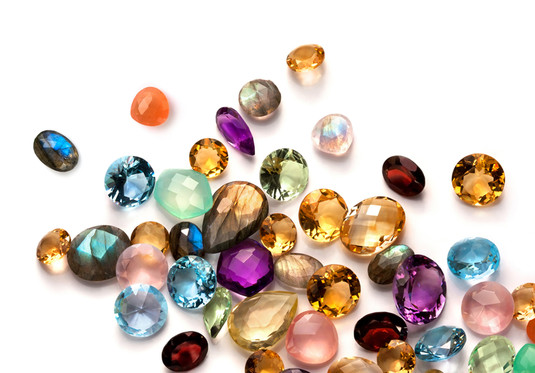
The traditional classification in the West, which goes back to the Ancient Greeks, begins with a distinction between precious and semi-precious; similar distinctions are made in other cultures. In modern usage the precious stones are diamond, ruby, sapphire and emerald, with all other gemstones being semi-precious.
This distinction reflects the rarity of the respective stones in ancient times, as well as their quality: all are translucent with fine colour in their purest forms, except for the colourless diamond, and very hard, with hardnesses of 8 to 10 on the Mohs scale. Other stones are classified by their colour, translucency and hardness.
The traditional distinction does not necessarily reflect modern values, for example, while garnets are relatively inexpensive, a green garnet called Tsavorite, can be far more valuable than a mid-quality emerald. Another unscientific term for semi-precious gemstones used in art history and archaeology is hardstone.
Use of the terms 'precious' and 'semi-precious' in a commercial context is, arguably, misleading in that it deceptively implies certain stones are intrinsically more valuable than others, which is not the case.
In modern times gemstones are identified by gemologists, who describe gems and their characteristics using technical terminology specific to the field of gemology. The first characteristic a gemologist uses to identify a gemstone is its chemical composition. For example, diamonds are made of carbon (C) and rubies of aluminium oxide (Al 2O 3). Next, many gems are crystals which are classified by their crystal system such as cubic or trigonal or monoclinic. Another term used is habit, the form the gem is usually found in. For example diamonds, which have a cubic crystal system, are often found as octahedrons.
Gemstones are classified into different groups, species, and varieties. For example, ruby is the red variety of the species corundum, while any other colour of corundum is considered sapphire. Other examples are the Emerald (green), aquamarine (blue), red beryl (red),goshenite (colourless), heliodor (yellow), and morganite (pink), which are all varieties of the mineral species beryl.
Gems are characterized in terms of refractive index, dispersion, specific gravity, hardness, cleavage, fracture, and luster. They may exhibit pleochroism or double refraction. They may have luminescence and a distinctive absorption spectrum.
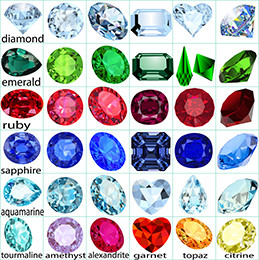
Material or flaws within a stone may be present as inclusions.
Gemstones may also be classified in terms of their "water". This is a recognized grading of the gem's luster and/or transparency and/or "brilliance". Very transparent gems are considered "first water", while "second" or "third water" gems are those of a lesser transparency.
Rubies
A ruby is a pink to blood-red coloured gemstone, a variety of the mineral corundum (aluminium oxide). The red colour is caused mainly by the presence of the element chromium. Its name comes from ruber, Latin for red. Other varieties of gem-quality corundum are called sapphires. The ruby is considered one of the four precious stones, together with the sapphire, the emerald and the diamond.
Prices of rubies are primarily determined by colour. The brightest and most valuable "red" called blood-red, commands a large premium over other rubies of similar quality. After colour follows clarity: similar to diamonds, a clear stone will command a premium, but a ruby without any needle-like rutile inclusions may indicate that the stone has been treated. Cut and carat (weight) are also an important factor in determining the price.
Generally, gemstone-quality corundum in all shades of red, including pink, are called rubies. However, in the United States, a minimum colour saturation must be met to be called a ruby, otherwise the stone will be called a pink sapphire. This distinction between rubies and pink sapphires is relatively new, having arisen sometime in the 20th century. If a distinction is made, the line separating a ruby from a pink sapphire is not clear and highly debated. As a result of the difficulty and subjectiveness of such distinctions, trade organizations such as the International Coloured Gemstone Association (ICA) have adopted the broader definition for ruby which encompasses its lighter shades, including pink.
Natural rubies can be evaluated using the four Cs together with their size and geographic origin.
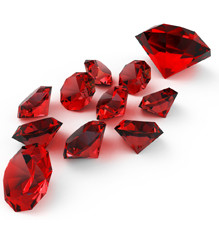
In the evaluation of coloured gemstones, colour is the most important factor. Colour divides into three components; hue, saturation and tone. Hue refers to "colour" as we normally use the term. Transparent gemstones occur in the following primary hues: red, orange, yellow, green, blue, violet. These are known as pure spectral hues. In nature there are rarely pure hues so when speaking of the hue of a gemstone we speak of primary and secondary and sometimes tertiary hues. In ruby the primary hue must be red. All other hues of the gem species corundum are called sapphire. Ruby may exhibit a range of secondary hues. Orange, purple, violet and pink are possible.
The finest ruby is best described as being a vivid medium-dark toned red. Secondary hues add an additional complication. Pink, orange, and purple are the normal secondary hues in ruby. Of the three, purple is preferred because, firstly, the purple reinforces the red making it appear richer.[11] Secondly, purple occupies a position on the colour wheel halfway between red and blue. In Burma where the term pigeon blood originated, rubies are set in pure gold. Pure gold is itself a highly saturated yellow. Set a purplish-red ruby in yellow and the yellow neutralizes its complement blue leaving the stone appearing to be pure red in the setting.
Sapphires
Sapphire (Greek: 'blue stone', which probably referred instead at the time to lapis lazuli) is a gemstone variety of the mineral corundum, an aluminium oxide (?-Al2O3). Trace amounts of other elements such as iron, titanium, chromium, copper, or magnesium can give corundum blue, yellow, purple, orange, or a greenish colour. Chromium impurities in corundum yield a pink or red tint, the latter being called a ruby.
Commonly, sapphires are worn in jewellery. Sapphires may be found naturally, by searching through certain sediments (due to their resistance to being eroded compared to softer stones) or rock formations. They also may be manufactured for industrial or decorative purposes in large crystal boules. Because of the remarkable hardness of sapphiresâ9 on the Mohs scale (the second hardest mineral, right behind diamond)âand of aluminium oxide in general, sapphires are used in some non-ornamental applications, including infrared optical components, such as in scientific instruments; high-durability windows; wristwatch crystals and movement bearings; and very thin electronic wafers, which are used as the insulating substrates of very special-purpose solid-state electronics (most of which are integrated circuits).
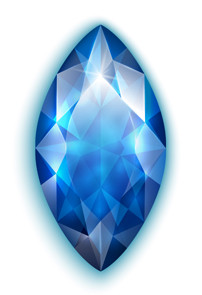
The sapphire is one of the three gem-varieties of corundum, the other two being ruby â defined as corundum in a shade of redâand padparadschaâa pinkish orange variety. Although blue is their most well-known colour, sapphires may also be colourless and they are found in many colours including shades of gray and black.
The cost of natural sapphires varies depending on their colour, clarity, size, cut, and overall quality â as well as their geographic origin. Significant sapphire deposits are found in Eastern Australia, Thailand, Sri Lanka, China (Shandong), Madagascar, East Africa, and in North America in a few locations, mostly in Montana. Sapphire and rubies are often found in the same geographic environment, but one of the gems is usually more abundant in any of the sites.
Blue sapphire
Colour in gemstones breaks down into three components: hue, saturation, and tone. Hue is most commonly understood as the "colour" of the gemstone. Saturation refers to the vividness or brightness of the hue, and tone is the lightness to darkness of the hue. Blue sapphire exists in various mixtures of its primary (blue) and secondary hues, various tonal levels (shades) and at various levels of saturation (vividness).
Blue sapphires are evaluated based upon the purity of their primary hue. Purple, violet, and green are the most common secondary hues found in blue sapphires. Violet and purple can contribute to the overall beauty of the colour, while green is considered to be distinctly negative. Blue sapphires with up to 15% violet or purple are generally said to be of fine quality. Blue sapphires with any amount of green as a secondary hue are not considered to be fine quality. Gray is the normal saturation modifier or mask found in blue sapphires. Gray reduces the saturation or brightness of the hue and therefore, has a distinctly negative effect.
The colour of fine blue sapphires may be described as a vivid medium dark violet to purplish blue where the primary blue hue is at least 85% and the secondary hue no more than 15%, without the least admixture of a green secondary hue or a gray mask.
The 423-carat (84.6 g) Logan sapphire in the National Museum of Natural History, in Washington, D.C., is one of the largest faceted gem-quality blue sapphires in existence.
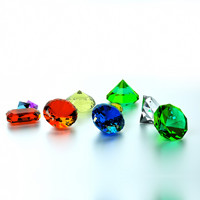
Fancy colour sapphire
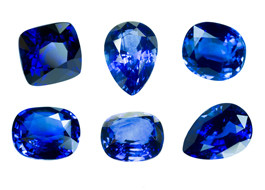
Yellow and green sapphires are also commonly found. Pink sapphires deepen in colour as the quantity of chromium increases. The deeper the pink colour the higher their monetary value, as long as the colour is tending toward the red of rubies. In the United States, a minimum colour saturation must be met to be called a ruby, otherwise the stone will be called a pink sapphire.
Sapphires also occur in shades of orange and brown. Colourless sapphires are sometimes used as diamond substitutes in jewellery. Natural padparadscha (pinkish orange) sapphires often draw higher prices than many of even the finest blue sapphires. Recently, more sapphires of this colour have appeared on the market as a result of a new artificial treatment method that is called "lattice diffusion".
Padparadscha
Padparadscha is a delicate light to medium toned pink-orange to orange-pink hue corundum, originally found in Sri Lanka, but also found in deposits in Vietnam and parts of East Africa. Padparadscha sapphires are rare; the rarest of all is the totally natural variety, with no sign of artificial treatment.
The name is derived from the Sanskrit "padma raga" (padma = lotus; raga = colour), a colour akin to the lotus flower (Nelumbo nucifera âSpeciosaâ).
Star sapphire

A star sapphire is a type of sapphire that exhibits a star-like phenomenon known as asterism; red stones are known as "star rubies". Star sapphires contain intersecting needle-like inclusions following the underlying crystal structure that cause the appearance of a six-rayed "star"-shaped pattern when viewed with a single overhead light source. The inclusion is often the mineral rutile, a mineral composed primarily of titanium dioxide. The stones are cut en cabochon, typically with the center of the star near the top of the dome. Occasionally, twelve-rayed stars are found, typically because two different sets of inclusions are found within the same stone, such as a combination of fine needles of rutile with small platelets of hematite; the first results in a whitish star and the second results in a golden-coloured star. During crystallisation, the two types of inclusions become preferentially oriented in different directions within the crystal, thereby forming two six-rayed stars that are superimposed upon each other to form a twelve-rayed star. Misshapen stars or 12-rayed stars may also form as a result of twinning. The inclusions can alternatively produce a "cat's eye" effect if the 'face-up' direction of the cabochon's dome is oriented perpendicular to the crystal's c-axis rather than parallel to it. If the dome is oriented in between these two directions, an 'off-center' star will be visible, offset away from the high point of the dome.
The Black Star of Queensland, the largest gem-quality star sapphire in the world, weighs 733 carats. The Star of India (weighing 563.4 carats) is thought to be the second-largest star sapphire (the largest blue), and is currently on display at the American Museum of Natural History in New York City. The 182-carat Star of Bombay, located in the National Museum of Natural History, in Washington, D.C., is another example of a large blue star sapphire. The value of a star sapphire depends not only on the weight of the stone, but also the body colour, visibility, and intensity of the asterism.
Colour change sapphire
A rare variety of natural sapphire, known as colour-change sapphire, exhibits different colours in different light. Colour change sapphires are blue in outdoor light and purple under incandescent indoor light, or green to gray-green in daylight and pink to reddish-violet in incandescent light. Colour change sapphires come from a variety of locations, including Thailand and Tanzania. The colour-change effect is caused by the interaction of the sapphire, which absorbs specific wavelengths of light, and the light-source, whose spectral output varies depending upon the illuminant. Transition-metal impurities in the sapphire, such as chromium and vanadium, are responsible for the colour change.
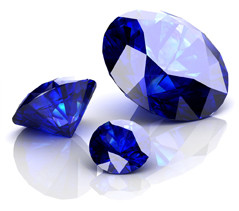
Certain synthetic colour-change sapphires have a similar colour change to the natural gemstone alexandrite and they are sometimes marketed as "alexandrium" or "synthetic alexandrite". However, the latter term is a misnomer: synthetic colour-change sapphires are, technically, not synthetic alexandrites but rather alexandrite simulants. This is because genuine alexandrite is a variety of chrysoberyl: not sapphire, but an entirely different mineral.
Source of colour
Rubies are corundum which contain chromium impurities that absorb yellow-green light and result in deeper ruby red colour with increasing content. Purple sapphires contain trace amounts of vanadium and come in a variety of shades. Corundum that contains ~0.01% of titanium is colourless. If trace amounts of iron are present, a very pale yellow to green colour may be seen. However, if both titanium and iron impurities are present together, and in the correct valence states, the result is a magnificent deep-blue colour.
Unlike localized ("intra-atomic") absorption of light which causes colour for chromium and vanadium impurities, blue colour in sapphires comes from intervalence charge transfer, which is the transfer of an electron from one transition-metal ion to another via the conduction or valence band. The iron can take the form Fe2+ or Fe3+, while titanium generally takes the form Ti4+. If Fe2+ and Ti4+ ions are substituted for Al3+, localized areas of charge imbalance are created. An electron transfer from Fe2+ and Ti4+ can cause a change in the valence state of both. Because of the valence change there is a specific change in energy for the electron, and electromagnetic energy is absorbed. The wavelength of the energy absorbed corresponds to yellow light. When this light is subtracted from incident white light, the complementary colour blue results. Sometimes when atomic spacing is different in different directions there is resulting blue-green dichrosism.
Intervalence charge transfer is a process that produces a strong coloured appearance at a low percentage of impurity. While at least 1% chromium must be present in corundum before the deep red ruby colour is seen, sapphire blue is apparent with the presence of only 0.01% of titanium and iron.
Emeralds

Emerald is a gemstone, and a variety of the mineral beryl (Be3Al2(SiO3)6) coloured green by trace amounts of chromium and sometimes vanadium. Beryl has a hardness of 7.5â8 on the 10-point Mohs scale of mineral hardness. Most emeralds are highly included, so their toughness (resistance to breakage) is classified as generally poor.
The word "Emerald" is derived (via Old French: Esmeraude and Middle English: Emeraude), from Vulgar Latin: Esmaralda/Esmaraldus, a variant of Latin Smaragdus, which originated in Greek: (smaragdos; "green gem").
Properties determining value
Emeralds, like all coloured gemstones, are graded using four basic parameters â the four Cs of Connoisseurship: Colour, Cut, Clarity and Crystal. The last C, crystal, is simply a synonym for transparency, or what gemologists call diaphaneity. Before the 20th century, jewelers used the term water, as in "a gem of the finest water", to express the combination of two qualities: colour and crystal. Normally, in the grading of coloured gemstones, colour is by far the most important criterion. However, in the grading of emeralds, crystal is considered a close second. Both are necessary conditions. A fine emerald must possess not only a pure verdant green hue as described below, but also a high degree of transparency to be considered a top gem.
In the 1960s, the American jewellery industry changed the definition of "emerald" to include the green vanadium-bearing beryl as emerald. As a result, vanadium emeralds purchased as emeralds in the United States are not recognized as such in the UK and Europe. In America, the distinction between traditional emeralds and the new vanadium kind is often reflected in the use of terms such as "Colombian Emerald".
Colour
In gemology, colour is divided into three components: hue, saturation and tone. Emeralds occur in hues ranging from yellow-green to blue-green, with the primary hue necessarily being green. Yellow and blue are the normal secondary hues found in emeralds. Only gems that are medium to dark in tone are considered emerald; light-toned gems are known instead by the species name green beryl. The finest emeralds are approximately 75% tone on a scale where 0% tone would be colourless and 100% would be opaque black. In addition, a fine stone should be well saturated; the hue of an emerald should be bright (vivid). Gray is the normal saturation modifier or mask found in emerald; a grayish-green hue is a dull green hue.
75% tone on a scale where 0% tone would be colourless and 100% would be opaque black. In addition, a fine stone should be well saturated; the hue of an emerald should be bright (vivid). Gray is the normal saturation modifier or mask found in emerald; a grayish-green hue is a dull green hue.
Emeralds are green by definition (the name is derived from the Greek word "smaragdus", meaning green) Emeralds are the green variety of beryl, a mineral which comes in many other colours that are sometimes also used as gems, such as blue aquamarine, yellow heliodor, pink morganite and colourless goshenite.
Clarity
Emerald tends to have numerous inclusions and surface breaking fissures. Unlike diamond, where the loupe standard, i.e. 10&mtimes; magnification, is used to grade clarity, emerald is graded by eye. Thus, if an emerald has no visible inclusions to the eye (assuming normal visual acuity) it is considered flawless. Stones that lack surface breaking fissures are extremely rare and therefore almost all emeralds are treated ("oiled", see below) to enhance the apparent clarity. Eye-clean stones of a vivid primary green hue (as described above) with no more than 15% of any secondary hue or combination (either blue or yellow) of a medium-dark tone command the highest prices. This relative crystal non-uniformity makes emeralds more likely than other gemstones to be cut into cabochons, rather than faceted shapes.
Contact us on:
Sources:

